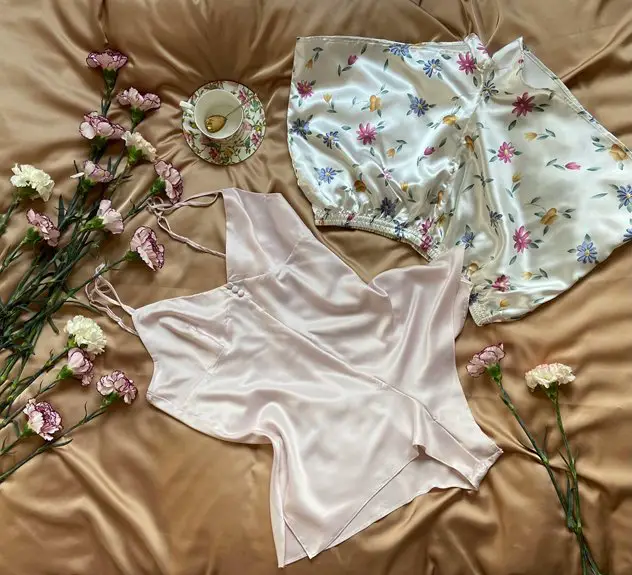Night sweats can feel like you’re trapped in a steam room, making restful sleep seem impossible. If you’ve been tossing and turning, drenched and uncomfortable, it’s time to rethink what you wear to bed. Choosing the right pajamas isn’t just about comfort—it’s about managing moisture and heat in a way that supports your body’s natural cooling process. Understanding which fabrics work best can change how you sleep, and here’s what you need to know.
Table of Contents
Key Takeaways
- Choose breathable fabrics like cotton blends, bamboo, or modal to enhance airflow and reduce night sweats.
- Avoid polyester, nylon, acrylic, and some cotton blends that trap heat and moisture, causing discomfort.
- Opt for moisture-wicking fabrics that pull sweat away from the skin, keeping you dry and cool.
- Select loose-fitting pajamas to improve ventilation and prevent heat buildup during sleep.
- Consider fabric weight and texture, using lightweight options in summer and moisture-wicking blends in winter for comfort.
Understanding Breathable Fabrics and Their Benefits
Although you mightn’t always notice it, the breathability of your pajama fabric plays an essential role in managing night sweats. When you choose breathable materials, you allow air to circulate freely, helping your skin stay cool and dry throughout the night.
Modern fabric technology enhances this effect by using specialized weaves and fibers designed to wick moisture away from your body efficiently. You’ll find that breathable fabrics prevent heat buildup, reducing discomfort and interruptions in your sleep.
Top Cooling Fabrics Ideal for Night Sweats
Choosing the right fabric makes a big difference in staying cool and comfortable during the night. When dealing with night sweats, you want pajamas made from top cooling fabrics that promote airflow and manage moisture effectively.
Cotton blends are excellent because they combine cotton’s softness and breathability with synthetic fibers that enhance durability and moisture wicking. This means you’ll stay dry and comfortable as sweat is drawn away from your skin.
Fabrics like bamboo and modal are also great choices—they’re naturally breathable and moisture-wicking, helping regulate your body temperature.
Fabrics to Avoid for a Comfortable Night’s Sleep
When you want to stay comfortable and dry all night, you should steer clear of fabrics that trap heat and moisture. Synthetic materials like polyester and nylon often do just that, making you feel hot and sticky. Even some cotton blends can retain moisture, reducing breathability and increasing discomfort. To help you choose wisely, here are fabrics to avoid:
| Fabric Type | Why Avoid It | Effect on Sleep |
|---|---|---|
| Polyester | Traps heat and sweat | Causes overheating |
| Nylon | Non-breathable, holds moisture | Leads to clammy feeling |
| Cotton Blends | Can retain moisture | Reduces airflow |
| Acrylic | Poor moisture absorption | Increases night sweats |
Avoiding these fabrics will help you experience a cooler, more restful night.
How Moisture Management Enhances Sleep Quality
Because your body naturally releases sweat to regulate temperature during sleep, managing moisture effectively keeps you comfortable throughout the night.
When your pajamas feature moisture-wicking properties, they pull sweat away from your skin, helping you stay dry and preventing that sticky, clammy feeling. This moisture management directly supports temperature regulation, ensuring your body doesn’t overheat or get too cold.
By keeping sweat in check, breathable fabrics reduce disruptions caused by discomfort, so you can enjoy deeper, more restful sleep. Choosing pajamas with efficient moisture-wicking abilities means you’ll wake up feeling refreshed instead of damp or restless.
Proper moisture management isn’t just about comfort—it’s key to maintaining a stable sleep environment that supports your overall health and well-being.
Tips for Choosing the Perfect Pajamas for Your Needs
To find pajamas that truly suit your needs, start by considering the fabric’s breathability and moisture-wicking abilities. These features help keep you cool and dry, especially if you struggle with night sweats.
Focus on breathable, moisture-wicking fabrics to stay cool and dry through the night, especially if you experience night sweats.
Think about pajama styles that allow airflow—loose-fitting tops and pants enhance ventilation better than tight options. Seasonal considerations also play a big role; lightweight cotton or bamboo works well for summer, while you might prefer moisture-wicking blends with a bit more warmth in winter.
Don’t forget to check the fabric’s weight and texture, as softer materials improve comfort.
Finally, prioritize pajamas that fit your personal preferences and sleep environment to guarantee you stay comfortable all night long.
Frequently Asked Questions
How Often Should Breathable Pajamas Be Washed for Optimal Freshness?
You should adjust your pajama washing frequency based on use, but generally, washing breathable pajamas after two to three nights guarantees ideal fabric care and keeps them fresh, comfortable, and effective at managing moisture.
Can Breathable Fabrics Help With Skin Irritation or Allergies?
Did you know 15% of people suffer from skin sensitivity? Choosing breathable fabrics can reduce irritation and provide allergy relief, letting your skin breathe and stay comfortable throughout the night without trapping sweat or allergens against your body.
Are There Specific Pajama Styles That Enhance Breathability?
You should choose lightweight designs with moisture-wicking options to enhance breathability. These styles help keep you cool and dry by promoting airflow and reducing sweat buildup, making your sleep more comfortable and irritation-free.
How Do Breathable Pajamas Perform in Humid Versus Dry Climates?
You’ll notice breathable pajamas handle humidity impact differently; in humid climates, they wick moisture to keep you cool, while in dry climates, they adapt by allowing airflow to prevent overheating, ensuring comfortable climate adaptation all night.
Can Breathable Fabrics Be Layered Without Losing Their Cooling Benefits?
You can layer breathable fabrics without losing cooling benefits by using smart layering techniques and selecting fabric combinations that wick moisture and allow airflow. This keeps you comfortable while managing night sweats effectively.
- The History and Evolution of Chamois Fabric - June 22, 2025
- Chamois Fabric on Wikipedia: What You Need to Know - June 22, 2025
- How to Pronounce Chamois Fabric Correctly - June 22, 2025






